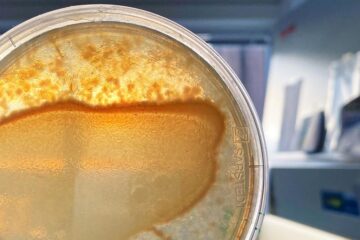Butterflies’ wings dazzle with science

The brilliant dazzle of butterflies’ wings could hold the key to a new type of optical material, called photonic crystals. Over the past 15 years, photonic crystals have attracted the attention of a vast international community, as scientists have begun to realise their potential applications in the field of optoelectronics and telecommunications.
According to Dr Luca Plattner, who undertook research in the School of Electronics and Computer Science at the University of Southampton, our understanding of the way that light is reflected from the wings of butterflies could lead to the fabrication of new photonic crystals. Dr Plattner investigated the optical properties of a periodic nanostructure found on the wings of a tropical butterfly, Morpho rhetenor. Several decades of scientific investigation had shown that understanding the source of the butterfly’s dazzling blue coloration required the use of the most advanced techniques employed in optical engineering.
Dr Plattner’s study explored the remarkable properties of the nanostructures and the physical mechanisms that produce them, both experimentally through optical measurements which complemented those reported by other scientists, and theoretically via cutting-edge simulation techniques developed for photonics. This enabled him to fabricate optical structures inspired by the butterfly microstructure using silicon-based materials and processes that are common in microelectronics. The work was carried out under the supervision of Professor Greg Parker.
‘The reason for studying the structure on the wings of that particular butterfly was that it has strong similarities to the photonic crystals already fabricated in the ECS Microelectronics Research Group,’ said Luca Plattner. ‘I was able to explore a biomimetic process, one in which we can learn new lessons from nature which are beneficial to both engineers and entomologists.’
Dr Plattner’s work will be published in the first print issue of the Royal Society’s Interface magazine, due out on 22 November.
Media Contact
Alle Nachrichten aus der Kategorie: Biowissenschaften Chemie
Der innovations-report bietet im Bereich der "Life Sciences" Berichte und Artikel über Anwendungen und wissenschaftliche Erkenntnisse der modernen Biologie, der Chemie und der Humanmedizin.
Unter anderem finden Sie Wissenswertes aus den Teilbereichen: Bakteriologie, Biochemie, Bionik, Bioinformatik, Biophysik, Biotechnologie, Genetik, Geobotanik, Humanbiologie, Meeresbiologie, Mikrobiologie, Molekularbiologie, Zellbiologie, Zoologie, Bioanorganische Chemie, Mikrochemie und Umweltchemie.
Neueste Beiträge

Das Mikrobiom verändert sich dynamisch und begünstigt wichtige Funktionen für den Wirt
Ein interdisziplinäres Forschungsteam des Kieler SFB 1182 untersucht am Beispiel von Fadenwürmern, welche Prozesse die Zusammensetzung des Mikrobioms in Wirtslebewesen steuern. Alle vielzelligen Lebewesen – von den einfachsten tierischen und…

Wasser im Boden – genaue Daten für Landwirtschaft und Klimaforschung
Die PTB präsentiert auf der Woche der Umwelt, wie sich die Bodenfeuchte mithilfe von Neutronenstrahlung messen lässt. Die Bodenfeuchte hat nicht nur Auswirkungen auf die Landwirtschaft, sondern ist als Teil…

Bioreaktor- und Kryotechnologien für bessere Wirkstofftests mit humanen Zellkulturen
Medizinische Wirkstoffforschung… Viele Neuentwicklungen von medizinischen Wirkstoffen scheitern, weil trotz erfolgreicher Labortests mit Zellkulturen starke Nebenwirkungen bei Probanden auftreten. Dies kann passieren, wenn zum Beispiel die verwendeten Zellen aus tierischem…





















